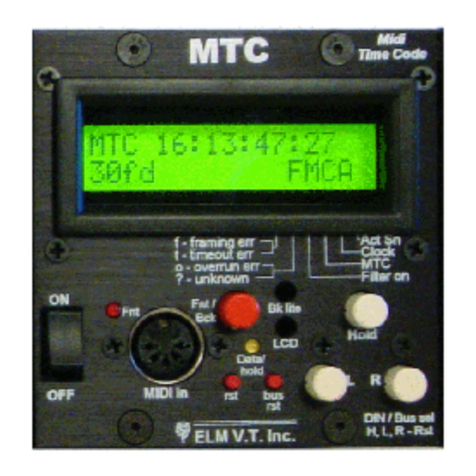
DECODE MODE
- The decode mode is selected in the program mode. Within the decode mode there is 2 modes of
operation; Display and old mode. In the Display mode all incoming MIDI data will be decoded and displayed. Any or All
message types can be programmed to be filtered out.
Quadrant: LCD Display Quadrants
1. will be the MIDI function
2. the Channel number
3. 1st data byte in decimal format*
4. 2nd data byte in decimal format*
5. MA1 and received midi message’s status
see LCD STATUS QUADRANT TABLE 1
* An ‘M’ = MSB (Most Significant Byte and an ‘L’ = LSB (Least Significant Byte . If followed by; an ‘h’ indicates hexadecimal format data.
By pressing the ‘ OLD’ button the unit enters the Hold mode. The LED indicator will come on. The displayed message is
the last message received. The left and right buttons will allow the user to scroll through the data. The arrows indicate
more data is present in that direction. Quadrant 2 toggles between the Channel number and the message number (the last
message received is message 1). The message number will increase as you scroll left and decrease as you scroll right for
all messages and quadrants 3 and 4 will display the decoded information. Quadrant 5 displays the hexadecimal data of the
message.
System Exclusive Messages (F0) - Sys Ex messages are displayed differently. Quadrant 1 displays the total number of
bytes in the Sys EX message. Quadrant 2 displays the YTE number directly above that byte. Once a Sys Ex message is
displayed the scrolling option will change. If the Sys Ex message has more than 7 bytes (which is the display range) then
the right arrow will be on, if you scroll right it will show the 8th byte within the Sys Ex message. Once your in a Sys Ex
display range the arrows indicate the direction of data in that range unless your at the head or end of the range indicated
by an ‘F0’ or ‘F7’, if so it will advance to the next message.
See Special Decode Feature below for special message handling.
No data is received during HOLD.
See Scroll layout table for scrolling description
.
Special Decode Features
The decode mode could add and change messages.
See the web sight ‘Midi Manufacturers Association’ for MIDI specifications. (
http://www.midi.org/
)
RUNNING STATUS
If a duplicating (status byte) message is sent more than once some devices will omit the 1st byte and send only byte(s)
2 (and 3). For example if a [‘NOTE ON’ Channel 3 / Note C4 / at 125 velocity] (92 60 7D hex) is sent and then a
[‘NOTE ON’ Channel 3 / Note C#4 / at 126 velocity] (92 61 7E hex) is sent the 2nd message may actually send only
[‘Note C#4 / at 126 velocity] ( 61 7E hex). This is known as Running Status. The MA1 will ADD the status byte to the
message.
**The hex mode will NOT add the status byte and will store exactly as it was received.
SYSTEM REAL TIME MESSAGES
Timing Clk, Start, Continue, Stop, Active Sensing, and System Reset (F8 - FFh) messages are sent in real time.
These messages can be INSERTED in the middle of other messages. The MA1 considers the ‘end of message’ to be
when the last of the data is received for that message. If a message is started and a ‘Real Time Message’ is sent that
message will be stored 1st then when the continuing message is complete it will be stored last.
**The hex mode will NOT INSERT status byte, all data bytes will display exactly as they are received.
3
www.elmvideotechnology.com
MA1_PC _Operations_Guide .lwp
copyright
©
ELM 2012-2016
























